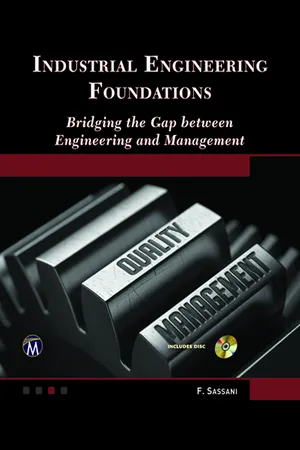Business
Organizational Structure Management
Organizational structure management refers to the design and arrangement of roles, responsibilities, and reporting relationships within a company. It involves creating a framework that outlines how various activities and processes are coordinated and controlled. Effective organizational structure management can enhance communication, decision-making, and overall efficiency within the business.
Written by Perlego with AI-assistance
Related key terms
Related key terms
1 of 4
Related key terms
1 of 3
11 Key excerpts on "Organizational Structure Management"
- eBook - ePub
Industrial Engineering Foundations
Bridging the Gap between Engineering and Management
- Farrokh Sassani(Author)
- 2016(Publication Date)
- Mercury Learning and Information(Publisher)
2ORGANIZATIONAL STRUCTURE2.1 IntroductionAn organization is an association of individuals supported by resources and capital working collectively to achieve a set of goals and objectives. There are many factors in effectively managing an organization, and one of the most essential is the organizational structure. Without a structure that defines the flow of information and physical entities, control of operations, and the tasks and responsibilities, it is doubtful that anything will function efficiently and as desired. It is then clear that the goals of any nature will be difficult to achieve.* Considering a manufacturing company as an example, Figure 2.1 shows the diversity of the functions and entities that could be involved.Referring to Figure 2.1 , it is hard to imagine how an enterprise can operate without thoughtfully bridging so many islands of activities and prescribing appropriate rules of conduct. Organizational structure and management are so important that it is essential that when even two individuals cooperate in a work effort, the tasks are divided, but only one of them directs the activities of the team. Otherwise, conflicting situations will arise. Therefore, every enterprise must have a well-integrated organizational structure for its personnel and departments, the form of which depends on the goals of the enterprise. A consulting firm, a hospital, or a chemical plant, for example, all have different organizational needs and structures. In a manufacturing or production company, the termproductionimplies transformational processes in which raw materials are converted into consumable goods and products. In doing so, the combination of manpower, machinery, tools, energy, and capital is required. This is a simplified definition. As depicted in Figure 2.1 - eBook - ePub
Project Management
A Systems Approach to Planning, Scheduling, and Controlling
- Harold Kerzner(Author)
- 2013(Publication Date)
- Wiley(Publisher)
Behavioralists contend that there is no one best structure to meet the challenges of tomorrow’s organizations. The structure used, however, must be one that optimizes company performance by achieving a balance between the social and the technical requirements.Organizations can be defined as groups of people who must coordinate their activities in order to meet organizational objectives. The coordination function requires strong communications and a clear understanding of the relationships and interdependencies among people. Organizational structures are dictated by such factors as technology and its rate of change, complexity, resource availability, products and/or services, competition, and decision-making requirements. The reader must keep in mind that there is no such thing as a good or bad organizational structure; there are only appropriate or inappropriate ones.Even the simplest type of organizational change can induce major conflicts. The creation of a new position, the need for better planning, the lengthening or shortening of the span of control, the need for additional technology (knowledge), and centralization or decentralization can result in major changes in the sociotechnical subsystem.Organizational restructuring is a compromise between the traditional (classical) and the behavioral schools of thought; management must consider the needs of individuals as well as the needs of the company. Is the organization structured to manage people or to manage work?There is a wide variety of organizational forms for restructuring management. The exact method depends on the people in the organization, the company’s product lines, and management’s philosophy. A poorly restructured organization can sever communication channels that may have taken months or years to cultivate; cause a restructuring of the informal organization, thus creating new power, status, and political positions; and eliminate job satisfaction and motivational factors to such a degree that complete discontent results. - Roger Mansfield(Author)
- 2013(Publication Date)
- Routledge(Publisher)
5ORGANIZATIONAL STRUCTURE AND ORGANIZATIONAL DESIGN
As we have noted already, one major set of decisions which confront management, particularly senior management, in any organization has to do with the design of the structure of the organizational system, or the administrative arrangements by which it is run. Of course, in many ongoing organizational situations, it may not always appear this way. Existing arrangements are often, perhaps all too often, seen as fixed, or at least non-problematic. None the less, whether consciously and systematically considered, or merely inherited and amended in the light of particular circumstances, organizational structures and administrative arrangements are largely the product of conscious Decision-making, usually by senior management. Of course, such Decision-making is constrained in a whole variety of ways, and subject to negotiation with other interested parties. In the present chapter, an attempt is made to examine the literature on organizational structure and design within the context of the ecological approach suggested. This will be done in an effort to understand both the nature of the issues that must be considered in making design decisions, and also to consider the likely implications of particular structural and administrative arrangements, which may ensue as a consequence of such decisions.The Nature of Organizational Structures
All organizations, be they industrial companies, schools or civil service departments are structured. That is to say, there are relatively defined relationships between different personnel, and more or less regularized procedures for carrying out the organization's business. Of course, any social system, such as a community or society, will be structured to some extent. However, in these other cases it would not normally be sensible to talk about the design of such structures, as they reflect a complex working through of economic, political and social relationships and processes. In these processes no party can typically think of attempting a total definition of the system in a sense which would justify the application of the concept of design. In formal organizations, on the other hand, the nature of the relationships involved, and particularly the authority system, make it possible and realistic for those in positions of authority to attempt to design an overall mode of operation. This is not to suggest that all participants will gladly assist in the execution of such designs, as any manager will be quick to realise. However, it is clear that, within limits, senior personnel can and do set out to define the relationships and procedures with and by which the organization is to function.- eBook - ePub
- Darren Lee-Ross, Conrad Lashley(Authors)
- 2012(Publication Date)
- Routledge(Publisher)
However, structuring organizations is not a haphazard affair (although sometimes it might feel that way). To be effective, firms must first contemplate:- where they are
- where they want to be.
In other words, they must formulate strategic plans based on a vision, their environment and other contingencies. Once a strategy is in place, the organizational structure and design can be planned, implemented and revisited depending on prevailing environmental factors.Reflective practice- Identify the formal structure and design of an organization of which you are a member or familiar with.
- Do you believe the above structure explains all of the tasks and processes encountered in your job?
- How do you think people react to jobs that are highly structured?
- Give some examples of how your attitudes and behaviour were affected by structures present in your employing organization.
- Do you believe that every individual member of an organization can be motivated by its structure all of the time?
- List four examples of leisure service jobs and whether you think they are best undertaken by individuals or groups.
Organizational Structure: What Does it Mean?In a generic sense, the Collins Oxford English Dictionary and Thesaurus defines structure as: ‘arrangement of parts in construction and buildings’. Hatch (1997) similarly comments that structure can relate to physical configurations existing within organizations, including buildings and geographical locations. Authors including Woodward (1958), Perrow (1967) and Galbraith (1973) view organizational structure in terms of technology and its impact on performance.While the above dimensions are undoubtedly structural, they are insufficient for our purpose. For example, Woodward, Perrow and Galbraith have a somewhat micro perspective more suited to ‘job design’ or ‘process engineering’. While Hatch’s perspective is broader it excludes the potential impact of environmental and strategic issues on organizational design. - eBook - ePub
The Self-Made Program Leader
Taking Charge in Matrix Organizations
- Steve Tkalcevich(Author)
- 2015(Publication Date)
- Auerbach Publications(Publisher)
3 Understanding Your Organizational StructureLooking back at Chapter 1 and the mind map of influential leaders you created, how do you currently stand with your identified skills for improvement, leadership traits, and your overall progress? This mind map will start each chapter to guide insight from this book and will give you the opportunity to compare your goals and progress along your journey. Always have an open discussion with your group of six to ten professionals on where you stand and if you have any roadblocks (Figure 3.1 ).If someone asks you what an organization is, what would you tell them? What does it mean to you? It can be best defined as a collective group of people systematically arranged to meet a need or obtain an ongoing goal. An organization structure is a framework that shows others the lines of authority, dictates formal communication channels, and allocates duties and rights to individuals. How does the organization structure impact the goal of the company? How does the structure affect the role of a project, program, or portfolio manager? Are there ways a project, program, or portfolio manager can maneuver and succeed in any organization structure? These questions have merit and will be discussed in this chapter.What makes one choose a particular organizational structure over another? There are times when multiple structures may have merit, but only one can be selected. Understanding the makeup of your organization structure will only work in your favor. There are four major factors that affect an organization’s structure: technology, strategy, human resources, and the organizational environment. These factors determine the organizational structure that will be used for the organization. Aligning the strategy with the direction your firm is headed will allow for smoother operations for example. This direction comes from top management with the involvement of the entire management team. Managers often work tirelessly to maintain the course set forth by the strategic direction and goals of the organization. - eBook - ePub
The Effective Public Manager
Achieving Success in Government Organizations
- Steven Cohen, William Eimicke, Tanya Heikkila(Authors)
- 2013(Publication Date)
- Jossey-Bass(Publisher)
CHAPTER FIVE STRUCTURING SYSTEMS, TASKS, AND RESPONSIBILITIESWith an excellent staff in place, an effective public manager must facilitate productive working relationships among the members of that staff. The degree and quality of staff interaction is influenced by an organization’s structure. Structure helps determine who will work with whom and how talents will be used. Tasks, like organizations, can also be structured or arranged to maximize the talents of a staff.This chapter focuses on how structuring your organization’s systems, tasks, and responsibilities can help you manage. It will help you determine when reorganization is worth your effort and what it should accomplish. A manager also needs to appreciate the fine line between allowing a staff member’s initiative and ideas to flourish and maintaining at least a semblance of control. A competent and effective manager knows how to break down projects into manageable tasks and how to ensure that the assigned tasks are fair and reasonable. The chapter concludes by discussing how you can be sure that work is assigned to the right people and that tasks are completed effectively.How the Organization’s Structure Can Help Managers Manage
The structure of an organization can be used to influence the behavior of the organization’s members. Reporting relationships can be rearranged and different missions can be emphasized by moving staffers into newly configured organizational units. Structure is important because most tasks in the modern world are complex and performed by groups, and performance will suffer if an organization’s work and structure are not in sync.The Purpose of Organizational Structure
Formal structure is an obvious and somewhat overrated feature of organizational life. Max Weber (1946) noted that formal hierarchy is a defining characteristic of bureaucracy. In a formal hierarchy, everyone must report to someone. Knowing whom you work for and knowing who works for you are fairly important aids to effective management. In contrasting bureaucracy with other forms of organization, Weber observed that bureaucracy’s great strength is its ability to break up work into small, efficiently performed tasks. Each task is performed by a distinct organizational unit. This division of labor allows organizational units to develop great expertise and facility with specific, narrowly defined tasks. Organizational structure therefore serves two essential purposes: it establishes how an organization defines and divides its work (division of labor), and it provides mechanisms for coordinating and integrating the work of separate organizational units (Gibson, 1978). - eBook - ePub
- James S. Tiller(Author)
- 2010(Publication Date)
- Auerbach Publications(Publisher)
9ORGANIZATIONAL MANAGEMENTAs introduced above, organizational management provides the executive and leadership team with the oversight that is necessary to ensure the entire security program is meeting expectations. As such, this embodies a number of strategic and tactical elements of security management that are important to the overall program, and also support elements of security that are necessary but not addressed directly by other features. Moreover, organizational management has the responsibility of establishing a coherent security strategy, one that is supported by a mission statement, charter, and objectives. It is important because it defines the security organization’s identity to others, helps those within the security group to understand their role and the direction of the group, and acts as a reference when the group is challenged to take on something different that may or may not be in alignment with the intended role of the security group. Clearly, this goes beyond just the ASMA; it should be reflected at the strategic level so that the business can resonate with the service delivery identity of the group (Table 9.1 and Figure 9.1 ).9.1 Organizational Structure
The structure of the organizational management team can take on many different forms, and each CSO will have a different approach. However, the following are organizational characteristics that should be considered:• Feature representation—The leaders of risk management, compliance management, governance, services management, and capability maturity management should report to the CSO and have a formalized forum to meet on a regular basis. Of course, each representative should have an opportunity to report on activities and needs from the others. - eBook - ePub
The Organizational Alignment Handbook
A Catalyst for Performance Acceleration
- H. James Harrington, Frank Voehl(Authors)
- 2011(Publication Date)
- Productivity Press(Publisher)
Figure 6.2 shows the interaction between the organization’s components and the environment in which it operates.FIGURE 6.2 Organizational environment.Organizational structure refers to the relationships among the parts of an organized whole. There are two types of structures: physical and social. Physical structure refers to relationships between the physical elements of an organization, such as its buildings and the geographical areas in which it conducts its business. Social structure refers to relationships among social elements, including people, positions, and the organizational units to which they belong (departments, sections, units, etc.). An organization is a social structure (bureaucracy) consisting of a hierarchy of authority, a division of labor, and formal rules and procedures (Max Weber).- Definition: Hierarchy reflects the distribution of authority among organizational positions. Hierarchy defines formal reporting relationships that map out upward communication channels through which management expects information to flow.
- Definition: Authority is the granting of the position holder certain rights, including the right to give direction to others and the right to reward and punish. These rights are called positional powers because they belong to the position rather than to the position holder.
- Definition: Division of Labor
- eBook - ePub
Strategic Analytics
Integrating Management Science and Strategy
- Martin Kunc(Author)
- 2018(Publication Date)
- Wiley(Publisher)
8 Organizational DesignObjectives
- To identify organizational aspects that facilitate the implementation of strategies
- To define organizational structures and processes
- To identify analytic tools to design organizational structures and processes
Learning outcomes and managerial capabilities developed
- To be able to use analytic tools to support organizational design
- To learn the critical aspects of organizational structures and processes
Chapter 7 discussed the use of resources and capabilities in implementing strategy. However, the strategy must be translated into organizational structure, processes, goals and control systems in order to be implemented on a daily basis. Strategy is operationalized through the coordination of multiple stakeholders (employees, suppliers, government, etc.). While strategy can be affected by the behavior of multiple stakeholders, strategy implementation is not only a top‐down process originated from the top management team but it also occurs bottom‐up when stakeholders make decisions every day. Therefore, the effectiveness of the implementation of strategies resides in the way that the organization is designed and organized. Peter Senge suggests the most important role of a leader is to be the designer of the organization who is not visible but whose consequences have impact over a long period of time. In his perspective, organization design implies building the foundations of purpose and core values, policies and structures that determine business decisions and effective learning processes (Senge, 1990 ). In this chapter, we develop how to design and improve business processes and organizational structure while Chapter 9 will review performance and control systems.One important aspect needs to be considered in terms of the size of the organization. Small businesses may not have the same needs in terms of organizational structure and control systems since the owner is inherently part of the implementation of the strategy. Owners make most of the key decisions. In large organizations, strategy formulation and implementation needs to be clearly communicated. One of the reasons for the development of organizations is the efficiency in producing products and delivering services, which originates from specialization and division of labor to tackle processes. However, specialization and division bring two problems: coordination to integrate the different tasks performed; and cooperation to align the interests of stakeholders performing the different tasks in the processes (Grant, 2013 ). Cooperation can be achieved through the establishment of hierarchies. Hierarchies employ different mechanisms to achieve coordination such as incentives (both positive and negative), authority and shared values. In terms of coordination, the methods are rules and norms, routines, and mutual adjustment (Grant, 2013 - eBook - ePub
- Cynthia Snyder PMP, Frank Parth PMP(Authors)
- 2006(Publication Date)
- Berrett-Koehler Publishers(Publisher)
Organizational Structure and the Strategic Role of Project Management After reading this chapter, you will be able to: • Explain various corporate structures. • Describe types of project offices. • Define strategic management and key strategic terms. • Describe how projects originate.In Chapter 1 , we developed some working definitions of operations, projects, and project management. We also looked at how IT project management differs from non-technical project management. In this chapter, we look at how organizations are structured, where project management fits in an organization, different types of project offices, and how projects can help organizations meet their strategic goals and objectives.COMPANY ORGANIZATIONAL STRUCTURES
The way an organization is organized and the reporting structure it adopts significantly affect the way projects are done and the authority that a project manager has. We are going to look at three basic types of organizational structures: functional, project driven, and matrix. We will also explore some of the varying ways that organizations combine them and move along the continuum of the matrix-type environment. We will look at the role of the project manager and some of the pros and cons associated with each type of environment.Functional
A functional environment is what we consider the traditional organizational structure. In a functional environment, various departments perform functions to support the company as a whole in meeting its objectives. Figure 2-1 shows a functional organization.Figure 2-1 . Functional Organization StructureThe advantage of a functional organization structure is that people with specific skill sets sit and work together and can support each other. The manager, whose responsibility it is to see that all work within the functional area is successfully accomplished, allocates their work. From an organizational standpoint, this is a very effective way to keep resources fully utilized. - eBook - ePub
The 30 Day MBA
Your Fast Track Guide to Business Success
- Colin Barrow(Author)
- 2023(Publication Date)
- Kogan Page(Publisher)
Just as the skeleton is the structure that holds a body together, a business too has its framework. The goal of any framework is to provide some boundaries while at the same time allowing the whole ‘body’ flexibility to respond in order to go about its business. While human bodies keep a very similar skeleton to the one they start out with, a business has a number of very different organizational structures to choose from. Also, it is unlikely that any one structure will be appropriate throughout an organization’s life.For an organization a structure has to perform the following functions:Figure 4.1 A framework for understanding organizational behaviourFigure 4.1 detailsThe outer circle shows environment and the middle circle shows strategy. The inner circle shows structure, people and systems. The structure lists organization and teams; the system lists reward, appraise, develop and change; the people lists recruit, motivate, manage and lead.- show who is responsible for what and to whom;
- define roles and responsibilities;
- establish communication and control mechanisms;
- lay out the ground rules for cooperation between all parts of the organization;
- set out the hierarchy of authority, power and decision making.
Pictorial methods of describing how organizations work have been around for centuries. Both the Roman and Prussian armies had descriptions of their hierarchical structures and the latter incorporated line and staff relationships. There is also some evidence that the ancient Egyptians documented their methods for organizing and dividing workers on major projects such as the pyramids. However, Daniel C McCallum is generally credited with developing the first systematic set of organizational charts in 1855, to organize railroad building on an efficient basis. The trigger for his innovation was the discovery that the building costs per mile of track did not drop with the length of line being built, contrary to logic. The inefficiencies were being caused by poor organization.Figure 4.2 Basic hierarchical organization chartBasic hierarchical organization
This simple structure has every member or part of the organization reporting in to one person (Figure 4.2
Index pages curate the most relevant extracts from our library of academic textbooks. They’ve been created using an in-house natural language model (NLM), each adding context and meaning to key research topics.
Explore more topic indexes
Explore more topic indexes
1 of 6
Explore more topic indexes
1 of 4










